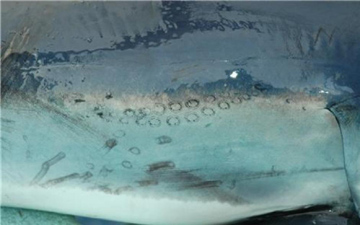It sounds like the start of a bad joke: What do an airplane wing and shark skin have in common? But a recent study suggests there’s a serious answer. Both of them provide a type of “lift” — one to get an airplane off the ground, the other to increase the shark’s speed.
 Close-up of mako shark skin. Credit: National Oceanic and Atmospheric Administration
Close-up of mako shark skin. Credit: National Oceanic and Atmospheric AdministrationA shark’s skin is covered with tiny scales, called denticles. Grooves in these scales channel water around the shark, reducing drag and increasing its speed and agility.
But researchers at Harvard realized that no one had tested the effects of the denticles on a moving shark. So they made a simulated shark in the lab. They bought freshly caught mako and porbeagle sharks from a fish market in Boston. They attached sections of the shark skin to a device that reproduces a shark’s swimming motion, then immersed them in a tank and channeled water across them. They did tests with the denticles in place and with them sanded down to a smooth surface.
The researchers found that not only did the denticles reduce drag, they also increased thrust — they boosted speed by about 12 percent.
And that’s where the airplane wing comes in. A wing is shaped in such a way that the air pressure is lower on the top than the bottom, creating a suction effect that “pulls” the airplane into the sky. The researchers say the denticles of a shark appear to perform the same function. Their shape reduces the water pressure ahead of them, creating a suction that pulls the shark forward — helping the shark “fly” gracefully through the water.

